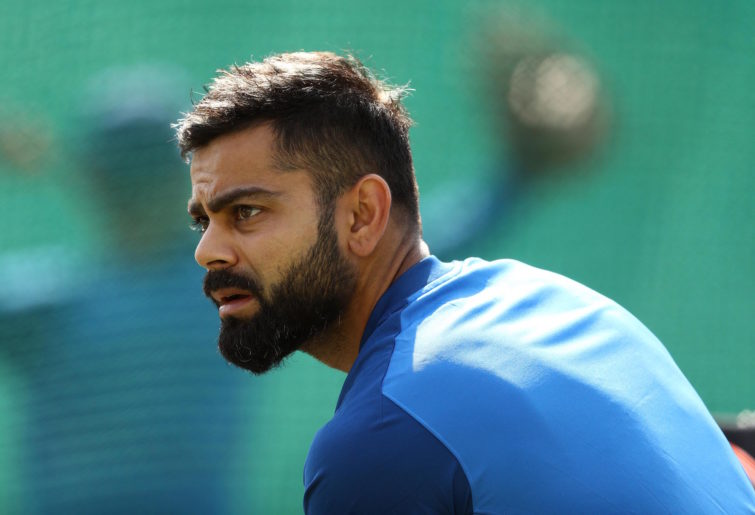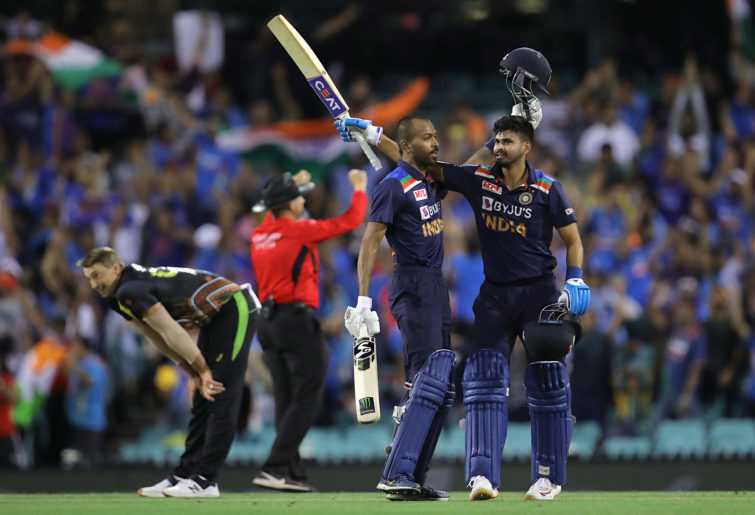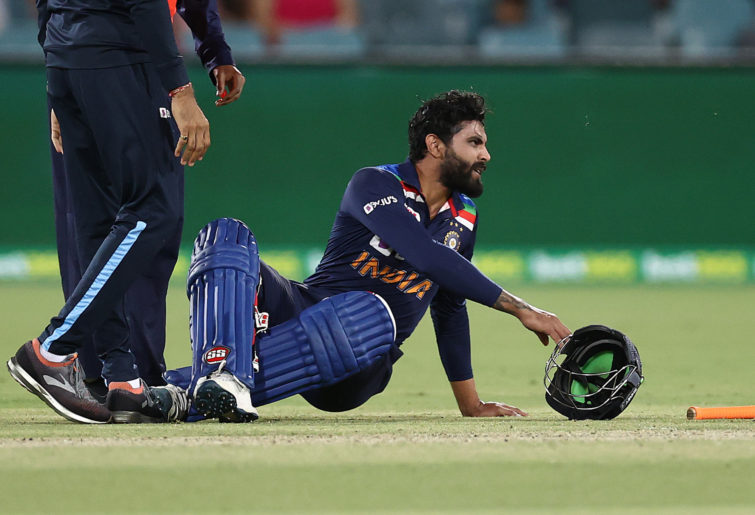After losing the ODI series, India hoped for a quick turnaround, and they achieved it with a 2-1 win in the T20I series.
Ravindra Jadeja and Yuzvendra Chahal starred in the first match to take India home in Canberra and Hardik Pandya’s onslaught brought India the series win in the second T20I at Sydney.
In the final match, Australian wicketkeeper Matthew Wade dominated the Indian bowlers with a knock of 80, before spinners Adam Zampa and Mitchell Swepson spun the game in Australia’s favour. Indian captain Virat Kohli’s knock of 85 went in vein.
With the series win, the Indian team will be high on confidence for the upcoming Test series that starts on December 17 at the Adelaide Oval.
The T20I series can also be considered as important in the lead-up to the next year’s World T20, to be played in India.
The visitors had several takeaways from the series. Some of them are as follows.
1. India will likely be one of main contenders to win the upcoming World T20
A lot of water will pass through the Murray before next year’s World Cup, but India are one of the strongest T20I sides in the world at the moment.
In Rohit Sharma and KL Rahul, they have an excellent opening pair (with Shikhar Dhawan being the other option) and Virat Kohli is top class. Hardik Pandya and Ravindra Jadeja are talented all-rounders and Jasprit Bumrah and Chahal are genuine wicket takers.

Jasprit Bumrah of India celebrates with Virat Kohli. (Photo by Visionhaus/Getty Images)
They have a strong pool to choose from for the remaining positions. The Indian Premier League has played a big role in unearthing talented cricketers for the format.
The team has performed consistently well on the field. The loss in the third T20I thwarted India’s nine-game winning run. They have won six of the last seven T20I series, with one ending in a draw.
Since the 2016 World T20, the Indian team has won 16 T20 series, and lost just four: two against the West Indies and on each against Australia and New Zealand. Three series ended in a draw.
With explosive batsmen, a good bowling attack and favourable home conditions, India could be the side to beat at the next year’s World T20.
Alongside England and the West Indies, they would start as one of the main contenders to win the tournament.
2. More questions than answers for India’s middle order
Like the ODIs, the Indian team has also faced middle order headaches in the T20 format. The team has failed to find stable batsmen at the number four and number five positions.
In the Australia series, Sanju Samson, Shreyas Iyer and Manish Pandey got an opportunity in those positions, but they failed.
At 48 runs, zero runs and two runs respectively, their contributions were paltry. Iyer’s unbeaten knock of 12 in the second T20I came while batting at number six.
Only Hardik Pandya could make merry, as while batting at number five in the second T20I at Sydney, his knock of 42 helped India achieve an unassailable 2-0 lead.
In the last two years, India have tried Kohli, Rahul, MS Dhoni, Rishabh Pant, Vijay Shankar and Shivam Dube in those positions apart from the aforementioned four, without a concrete solution.

(Robert Cianflone/Getty Images)
Rahul is better suited as an opener, Kohli’s preferred position is one down and Pandya has mostly been preferred at number six. MS Dhoni is retired.
Iyer hasn’t been consistent. Only twice in eight T20 series his average has crossed 25. In his T20I career, Iyer has scored 429 runs in 22 innings at an average of 26.81 and a strike rate of 130.79.
Manish Pandey, who is mostly preferred at number five or number six, has a career T20I strike rate of just over 126, and Rishbah Pant has averaged 20.50 in 25 T20I innings and scored his runs at at 121.66.
Recently, the names of Suryakumar Yadav, Ishan Kishan and Nitish Rana have made rounds to be tried at those positions.
If India can’t solve the middle-order conundrum soon and find a permanent answer, it could be the Achilles heel for their World T20 campaign.
3. The emergence of Hardik Pandya
Hardik Pandya is a feature-worthy cricketer. A serial match winner on his day, his talent, eccentricities and actions, both on and off the field, have attracted a lot of attention.
He has been a divisive cricketer – his supporters have backed him all the time, and detractors have left no stone unturned to criticise him. However, the last couple of months have changed it all.
He was one of the star acts of the Mumbai Indians’ dominant IPL 2020 campaign. Preferred to bat at number five, Pandya scored 281 runs in 13 innings at an average of over 35 and a strike rate of around 179.
Alongside the West Indian Kieron Pollard, Pandya formed a menacing partnership, which blew away the opposition.
He brought the same form to Australia but went up a notch. He was India’s standout player across both the limited-overs series.

Hardik Pandya and Shreyas Iyer. (Photo by Matt King – CA/Cricket Australia via Getty Images)
The visitors lost the ODI series 2-1, but with 210 runs in three innings at an average of 105, Pandya was their highest scorer. His knock of 92* was instrumental as India got a consolation win in the third ODI.
In the T20 series, his 42* won India the second game in Sydney. Overall he scored 78 runs at an average of 39 and a strike rate of over 156 in three innings. He won the man of the series award and won more hearts when he handed away the trophy to pacer T Natarajan, saying that he deserved it for his bowling display.
Pandya has become a reliable middle order player for India and has also worked hard to improve his batting technique.
He hasn’t bowled much since coming back from his back injury, but is likely to start bowling in the coming months.
If he starts to bowl again, can continue to keep his form and perform to his potential, Pandya is the X factor that the Indian team has craved.
4. India’s all-rounder problems and the lack of a sixth bowling option
While Hardik Pandya performed well as a batsman in the series, his lack of bowling proved to be a handicap for India as they went in every match with only five bowling options.
The visitors played with four front-line batsmen who couldn’t bowl (Dhawan, Kohli, Iyer/Pandey and Pandya), two wicketkeepers (Rahul and Samson), two spin-bowling all-rounders in the first match (Ravindra Jadeja and Washington Sundar) and three pacers (Mohammed Shami, Deepak Chahar and T Natarajan).
Jadeja was replaced as a concussion substitute by Yuzvendra Chahal in the first match and he ended up bagging the man-of-the-match honours.

Ravindra Jadeja’s concussion substitution sparked controversy in Canberra. (Photo by Ryan Pierse – CA/Cricket Australia via Getty Images)
For the next two matches, Shami was replaced by Shardul Thakur while Chahal played instead of the injured Jadeja.
In comparison, Australia used at least six bowlers in every match.
Throughout the series, the Indian bowlers went at over 8.7 runs an over on average. At around 6.91 runs an over, T Natarajan performed the best, while both Thakur (10.25 runs an over in two innings) and Shami (11.50 runs an over in one innings) went at over ten.
The series was high scoring and Kohli had nobody to go to when the runs started to leak. Both the times when Australia crossed 180 (194 and 186 respectively), they could have crossed 200 but the Indians took wickets at regular intervals to pull Australia down.
Pandya bowled for the first time since his back surgery in the second ODI against Australia at Sydney, and is expected to resume bowling soon, giving Kohli an extra bowling option.
However, if he doesn’t bowl, India could have their task cut out. Pandya is a good enough to be in the team solely as a batsman but in that case, the team dynamics will need to be changed.
So what could happen? Pandya could bat at number five or number six based on the match situation. One of the batsmen currently occupying the number four or number five positions will make way.
If India want to go for a pacer all-rounder, Vijay Shankar may be the likely option. A batting all-rounder, he has played four T20 innings for India and scored 101 runs at an average of 25.25 and has scored at over 138. He has taken five wickets at a bowling average of just over 38 and an economy rate of around nine.
Shivam Dube is another possible batting all-rounder. Until now, he has scored 105 runs in nine T20 innings for India at an average of 17.03 and a strike rate of over 135. He has also taken five wickets at a bowling average of just over 43.20 and an economy rate of 10.04.

(Mark Kolbe/Getty Images)
Among spin-bowling all-rounders, Krunal Pandya or Axar Patel could feature.
The senior Pandya has scored 121 runs at an average of 24.20 and a strike rate of 131.52 for India. He has taken 14 wickets at an average of around 38 and economy rate of just over eight in 18 matches. He has been one of the most consistent performers for the Mumbai Indians in the IPL and has also won three man-of-the-match awards in T20Is for India.
Patel has played 11 T20 matches for India, scoring 68 runs at an average of 17 and a strike rate of 125.92 and taken nine wickets at an average of around 29.50 and an economy rate of under seven.
Among the uncapped all-rounders, Harshal Patel, Shivam Mavi, Kamlesh Nagarkoti and Rahul Tewatia could find themselves in contention.
India need to solve the all-rounder situation or feature a batsman like Nitish Rana, who can contribute with the ball if required to ease the pressure on their bowlers.
Having only five bowling options at their disposal is never ideal for any captain, and Kohli is not an exception.
5. The rise of T Natarajan could be good news for the Indian team
With six wickets in three matches at an average if 13.83 and an economy rate of just under seven, T Natarajan was the best bowler of the series.
He was so influential in India’s 2-1 series win that man of the series Hardik Pandya chose to hand over his trophy to Natarajan for his exploits.
He also impressed legendary Glenn McGrath with his performances. The Australian labelled Natarajan “the find of this tour” for India.
He wasn’t even a part of India’s T20I squad originally, as Natarajan replaced Varun Chakravarthy when the latter got ruled out of the series with a shoulder injury.
Natarajan’s stock initially rose in the recent IPL season, when he took 16 wickets in 16 matches at an average of just over 31 and an economy rate of just over eight.
More importantly, he won several accolades for his pitch perfect yorkers. His dismissal of AB de Villiers in the elimination knock-out match was considered as one of the balls of the tournament.
India great Virender Sehwag has already backed Natarajan to form India’s pace-attack trio along with Jasprit Bumrah and Bhuvneshwar Kumar.
Bumrah is the world’s best T20 bowler and Kumar is no pushover either. He has 185 career wickets in T20s, and goes at an economy rate of just over seven.
The average run rate of the aforementioned trio is a mere 7.23 and they have a knack of taking wickets.
After the series, Kohli said that Natarajan, if he can maintain his form, could be a great addition to India’s World T20 squad. The captain also lauded him for standing up and delivering for the team under pressure, especially in the absence of Bumrah and Shami.
In Natarajan, India have got a left-arm seamer that they have craved.
All of Bumrah, Shami, Kumar, Shardul Thakul, Mohammad Siraj and Navdeep Saini (the pacers in contention for the India’s T20 side) are right-arm bowlers. Therefore, the emergence of Natarajan is like a breath of fresh air.
He brings variety to India’s bowling and all things considered, his rise is good news for the Indian team.

































































































